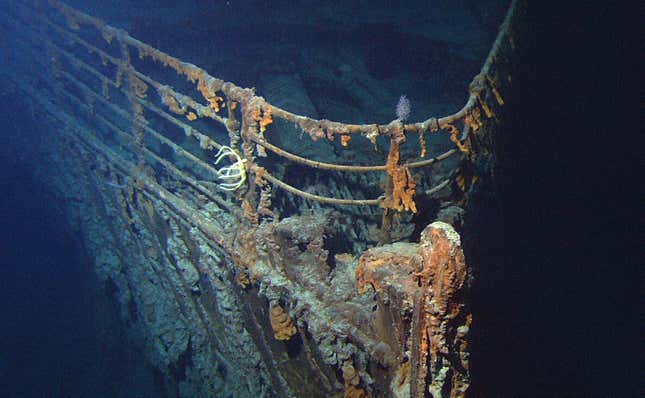
Looking a bit like a beached whale on the ocean floor, the Titanic has been a perpetual state of decay since it settled there on April 15, 1912. This week, a exploration company may launch an expedition to survey the wreck’s current state, the first of what would likely become an annual trip to the site.
The company, OceanGate Expeditions, made waves last year when it announced that paying customers would be able to visit the wreck by shelling out over $100,000 apiece, as previously reported by Gizmodo. There will be three paying customers on each trip aboard OceanGate’s vessel, a carbon fiber-and-titanium submersible called Titan.
There are plenty of legal and ethical quandaries around shipwrecks, which may contain valuable artifacts but are also gravesites. At 12,500 feet below the surface, Titanic is no different than many of those vessels, but for its immense scale and its fame. That fame has made it a regular subject for talks of salvage and conservation, dating back to before the wrecked steamer was discovered in 1985. Some believe objects should be recovered, though such an operation would be complex and costly. Others argue that the ship is best protected as a mass grave of the more than 1,500 people who died when it sank. The OceanGate team is planning to chronicle the wreck’s deterioration.
“The ocean is taking this thing, and we need to document it before it all disappears or becomes unrecognizable,” Stockton Rush, OceanGate’s president, told the AP on a ship headed to the North Atlantic wreck site. Besides the deep-sea denizens—mostly bacteria and archaea—that make a meal of the steel and other materials that constituted the vessel, strong and shifting ocean currents have long prevented the ship from being otherwise sheltered in the muck on the Atlantic seafloor. For 109 years, the wreck has withstood such hazards, but time is taking its toll. “At some point you would expect the railing on the bow, which is very iconic, to have collapsed,” Rush said.
Some iconic parts of the purportedly unsinkable ship have long been gone, like the grand staircase—which made a convenient entry point for ROV submersibles. But others, like the 100-foot forward mast and the crow’s nest, have collapsed since the wreck’s discovery. The poop deck’s fallen in, and even the eerie sight of captain E.J. Smith’s bathtub is now lost, as a 2019 starboard collapse took out the officers’ quarters.

Titan’s instruments include high-definition cameras and multi-beam sonar equipment, Rush said, which will allow the company to better understand the ship’s debris field, ecology, and the progression of its decay. The paying members of Titan’s crew—tickets range from $100,000 to $150,000 per person, according to the AP—will also operate the sonar equipment and perform other research tasks. Marine biologists and archaeologists are also involved with the OceanGate expedition and will likely contribute to the mission’s scientific goals.
The Titanic has long fascinated us a story of human tragedy, hubris, and the limits of our technologies in the face of nature. Over 5,000 artifacts have been taken from the wreck, and some controversially sold. In 2016, the largest owner of Titanic artifacts went bankrupt, and various groups bid for ownership of the objects, including one group involving James Cameron. An investment group including the private equity firm Apollo ended up nabbing the artifacts for $19.5 million. Hopes of recovering more of the wreck were dealt a hefty blow last year, when a salvage firm wanting to retrieve the ship’s telegraph machine was rebuffed by U.S. government lawyers, who said the work would violate federal law and a pact with Great Britain, from which the ship sailed.
More: Here’s What Protects Shipwrecks From Looters and Hacks